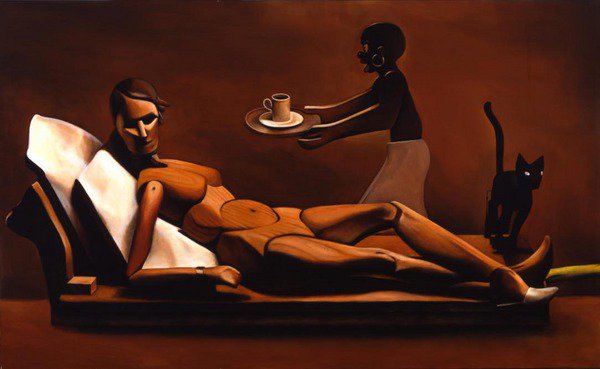I Love Holland
dal 20/9/2013 al 5/9/2015
Segnalato da
20/9/2013
I Love Holland
Stedelijk Museum Schiedam, Schiedam
Dutch post-war art. The overview presents more than a hundred artworks by more than sixty artists who have had a major influence on art between 1945 and the present day. The Second World War, liberty and newly gained freedom are elucidated in this framework.

‘The exhibition in the Stedelijk Museum Schiedam is one we all eagerly await.’
With the exhibition entitled Ik hou van Holland. Nederlandse kunst na 1945 (I Love Holland. Dutch post-war art), the Stedelijk Museum Schiedam will present a comprehensive overview of post-war Dutch art. An overview of this quality, magnitude and depth has never been shown in the Netherlands. It displays the developments in Dutch contemporary art, and links these to developments in society.
Artists are often the first to observe and reflect on what is going on in the world, and this exhibition makes this evident. The overview presents more than a hundred artworks by more than sixty artists who have had a major influence on art between 1945 and the present day. On 21 September, the exhibition will open with a nostalgic dance party in the style of the (post-)war years 1940 and 1950.
I Love Holland. Dutch post-war art reveals that many taboos in both art and society were demolished in this period, and new norms championed: the freedom that followed the Second World War was mirrored in art and society. An exceptional aspect of this unique overview is that art is shown in relation to recognizable social, political and economic events in Dutch society. ‘An approach that wishes to draw art out of its ivory tower, to an extent not previously seen in the Netherlands’ (Rutger Pontzen in de Volkskrant, 30 August 2013).
Artists in the exhibition:
Karel Appel, Eugène Brands, Constant, Lotti van der Gaag, Lucebert, Anton Rooskens, Theo Wolvecamp, Tom America, Corneille, Armando, Joost Baljeu, Ad Dekkers, Daan van Golden, Jan Henderikse, Henk Peeters, Jan Schoonhoven, Peter Struycken, JCJ VanderHeyden, herman de vries, Bas Jan Ader, Woody van Amen, Gustave Asselberg, Marinus Boezem, Maria van Elk, Ger van Elk, Reinier Lucassen, Jan van Munster, Wim T. Schippers, Wim van der Linden, Co Westerik, Jan Dibbets, Shinkichi Tajiri, Marlene Dumas, Marina Abramovic and Ulay, Joep van Lieshout, René Daniëls, Rineke Dijkstra, Inez van Lamsweerde, Berend Strik, Henk Tas, Henk Visch, Rob Scholte, Karin Arink, Atelier Van Lieshout, Sara Blokland, Robbie Cornelissen, Erik van Lieshout, Fransje Killaars, Gert Jan Kocken, Job Koelewijn, Dwight Harold Marica, Aernout Mik, Ronald Ophuis, Andrei Roiter, Maria Roosen, Julika Rudelius, Charlotte Schleiffert, Esther Tielemans, Aji V.N., Anne Wenzel.
Themes, mottos and the social context
War & Liberty - ‘Barbarian Times’
Reconstruction & Prosperity - ‘Homo Ludens’
Comfort & Cold War - ‘Soft Living’
Identity & Malleability - ‘New Holland’
Boundlessness – ‘Open Borders’
The art from the post-war years can be reviewed within the theme of War & Liberty. The Second World War, liberty and newly gained freedom are elucidated in this framework. The exhibition subsequently focuses on Reconstruction & Prosperity. The Delta Works and the new Bijenkorf department store in Rotterdam are examples from this period. In Comfort & Cold War era concentrates on the arrival of television and the Iron Curtain. Characteristic features of the Identity & Malleability aspect are the social-critical attitude of certain groups among the population on the one hand, and the malleability of groups of people, with yuppies as the personification of this, on the other. The last theme, Boundlessness, brings us closer to the present day. The fall of the Berlin Wall was one of the most important events in this period, as was also the advent of the World Wide Web.
Special opening evening with Radio Modern on 21 September
Ik hou van Holland. Nederlandse kunst na 1945 will be opened in the style of the (post-)war years 1940 and 1950, the same period that marks the beginning of the overview. The Stedelijk Museum Schiedam has organized a dance party in conjunction with Radio Modern. It will be a nostalgic trip to the post-war years. Visitors will be able to participate in dance lessons, a band will perform live, visitors can go to the barber’s shop and be photographed in splendid 1950s clothes.
Image: Rob Scholte, Utopia, 1986, oil on canvas, 161,3 x 256,5 cm, collection Museum Boijmans van Beuningen, Rotterdam
Press contact:
Henny van Leeuwen Tel: + 31 (0)10 2463662 or +31 (0)6 10423487 E-mail: henny.van.leeuwen@stedelijkmuseumschiedam.nl
Stedelijk Museum Schiedam
Hoogstraat 112-114 3111 HL Schiedam
Every day 10.00 - 17.00, monday closed
Regular admission € 9,00
with discount € 4,50
Free admission Childeren (0 to and including 12 years)



